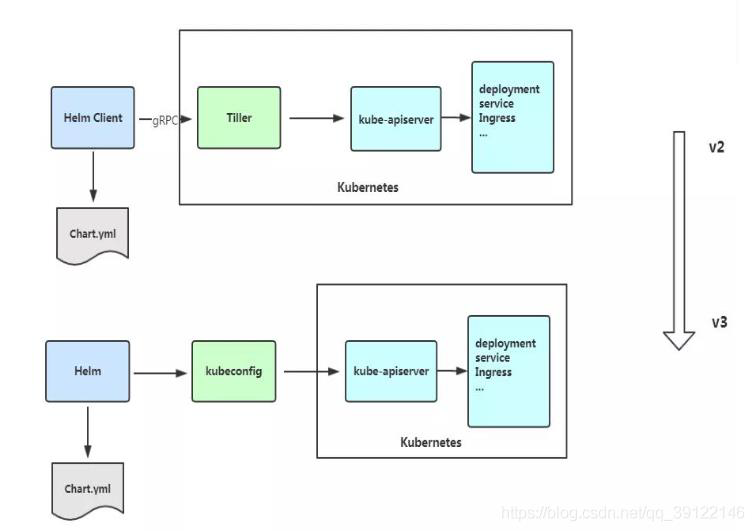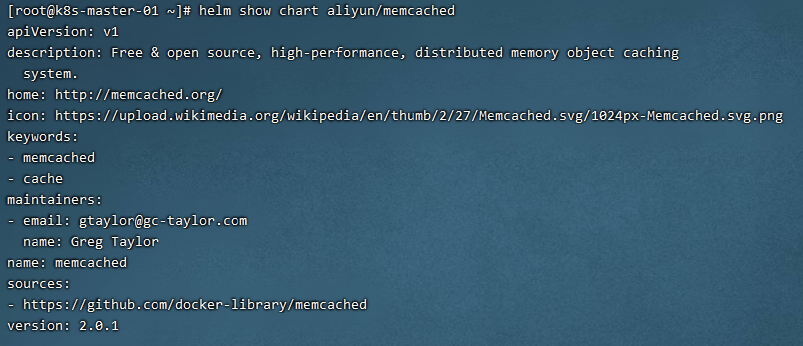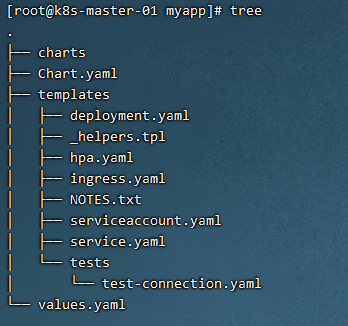企业级实战模块九:Kubernetes Helm包管理工具
官网:
https://v3.helm.sh/zh/docs/
Helm是kubernetes的包管理工具,相当于linux环境下的yum/apg-get命令。
Helm的首要目标一直是让 从零到 Kubernetes” 变得轻松。无论是 运维、 开发人员、经验丰富的 DevOps工程师,还是刚刚入门的学生, Helm 的 目标是让大家在两分钟内就可以在 Kubernetes 上安装应用程序。
Helm 可以解决的问题:运维人员写好资源文件模板交给 开发人员填 写 参数即可
Helm中的一些概念:
-
helm:命令行客户端工具,主要用于 Kubernetes 应用 中的 chart 的创建、打包、发布和管理。
-
Chart: helm 程序包 ,一系列用于描述 k8s 资源相关文件的集合 ,
-
比方说我们部署nginx,需要deployment.yaml,需要service的yaml,这两个清单文件就是一个helm程序包,在k8s中把这些yaml清单文件叫做chart图表。
-
vlues.yaml文件为模板中的文件赋值,可以实现我们自定义安装
-
如果是chart开发者需要自定义模板,如果是chart使用者只需要修改values.yaml即可
-
repository:存放chart图表的仓库,提供部署k8s应用程序需要的那些yaml清单文件
-
chart--->通过values.yaml这个文件赋值-->生成release实例
-
helm也是go语言开发的
-
-
Release :基于 Chart 的部署实体,一个 chart 被 Helm 运行后将会生成对应的一个 release ;将在k8s 中创建出真实运行的资源对象。
helm把 kubernetes 资源打包到一个 chart 中,制作并完成各个 chart 和 chart 本身依赖关系并利用chart 仓库实现对外分发,而 helm 还可通过 values.yaml 文件完成可配置的发布,如果 chart 版本更新了, helm 自动支持滚更更新机制,还可以一键回滚,但是不是适合在生产环境使用,除非具有定义自制chart 的能力 。
2 Helm V3版本变化
2019年 11 月 13 日, Helm 团队发布 Helmv3 的第一个稳定版本。

该版本主要变化如下:
架构变化:
-
Helm 服务端 Tiller 被 删除
-
Release 名称可以在不同命名空间重用
-
支持将 Chart 推送至 Docker 镜像仓库中
-
使用 JSONSchema 验证 chartvalues
3 安装Helm V3
K8s版本支持的各个 helm 版本对照表:
https://helm.sh/zh/docs/topics/version_skew/

# 下载软件包
wget https://get.helm.sh/helm-v3.6.3-linux-amd64.tar.gz
# 解压
tar zxvf helm-v3.6.3-linux-amd64.tar.gz && mv linux-amd64/helm /usr/local/bin/

4 配置chart仓库
阿里云仓库
https://kubernetes.oss-cn-hangzhou.aliyuncs.com/charts
官方仓库
https://hub.kubeapps.com/charts/incubator
微软仓库
http://mirror.azure.cn/kubernetes/charts/charts/
4.1 添加阿里云chart仓库
# 添加仓库
helm repo add aliyun https://kubernetes.oss-cn-hangzhou.aliyuncs.com/charts

# 更新本地仓库
helm repo update
4.2 常用命令
# 添加chart仓库
helm repo add <chart-name> <chart-url>
# 查看chart仓库
helm repo list
# 删除chart仓库
helm repo remove <chart-name>
# 更新chart仓库
helm repo update
# 搜索chart仓库
helm search repo <chart-name>
5 基本使用
5.1 搜索和下载Chart
1)查看阿里云 chart 仓库中的 memcached
helm search repo aliyun | grep memcached

2)查看chart信息
helm show chart aliyun/memcached

3)下载chart包到本地
helm pull aliyun/memcached
tar zxvf memcached-2.0.1.tgz && cd memcached

-
Chart.yaml: chart 的基本信息,包括版本名字之类
-
templates:存放 k8s 的部署资源模板,通过渲染变量得到部署文件
-
values.yaml:存放全局变量 templates 下的文件可以调用

-
_helpers.tpl:存放能够复用的模板
-
NOTES.txt:为用户提供一个关于 chart 部署后使用说明的文件
5.2 部署chart
生成环境中不建议使用
1)修改 templates/statefulset.yaml api版本信息

2)添加selector字段
selector:
matchLabels:
app: {{ template "memcached.fullname" . }}
chart: "{{ .Chart.Name }}-{{ .Chart.Version }}"
release: "{{ .Release.Name }}"
heritage: "{{ .Release.Service }}"

3)删除affinity亲和性配置

4)安装
helm install mamcached ./

kubectl get pods,sts

5)测试
# If you'd like to test your instance, forward the port locally:
export POD_NAME=$(kubectl get pods --namespace default -l "app=mamcached-memcached" -o jsonpath="{.items[0].metadata.name}")
kubectl port-forward $POD_NAME 11211
# In another tab, attempt to set a key:
echo -e 'set mykey 0 60 5\r\nhello\r' | nc localhost 11211

5.3 release相关操作
1)查看release
helm list

2)删除release
helm delete mamcached
6 自定义Chart模板
6.1 自定义一个Chart
helm create myapp

├── charts 用于存放所依赖的子 chart
├── Chart.yaml 描述这个 Chart 的相关信息、包括名字、描述信息、版本等
├── templates 模板目录,保留创建 k 8s 的资源清单文件
│ │
│ ├── deployment.yaml deployment 资源的 go 模板文件
│ │
│ ├── _helpers.tpl # 模板助手文件,定义的值可在模板中使用
│ │
│ ├── hpa.yaml 水平 pod 自动扩缩容 go 模板文件
│ │
│ ├── ingress.yaml 七层代理 go 模板文件
│ │
│ ├── NOTES.txt
│ │
│ ├── serviceaccount.yaml
│ │
│ ├── service.yaml service 的 go 模板文件
│ │
│ └── tests
│ │
│ └── test connection.yaml
└──values.yaml 模板的值文件,这些值会在安装时应用到 GO 模板生成部署文件
6.2 Chart编写规则
apiVersion: v2
name: myapp
description: A Helm chart for Kubernetes
version: 0.0.1
appVersion: "latest"
type: application
maintainer:
- name: gudu
wechat: gududexiaorenwu
appVersion: "1.16.0"
解释说明:Chart.yaml 文件主要用来描述对应 chart 的相关属性信息,其中 apiVersion 字段用于描述对应 chart 使用的 api 版本,默认是 v2 版本; name 字段用于描述对应 chart 的名称; description 字段用于描述对应 chart 的说明简介; type 字段用 户描述对应 chart 是应用程序还是库文件,应用程序类型的chart ,它可以运行为一个 release ,但库类型的 chart 不能运行为 release ,它只能作为依赖被application 类型的 chart 所使用; version 字段用于描述对应 chart 版本; appVersion 字段用于描述对应 chart 内部程序的版本信息;
6.3 GO模板文件渲染
apiVersion: apps/v1
kind: Deployment
metadata:
name: {{ include "myapp.fullname" . }}
labels:
{{- include "myapp.labels" . | nindent 4 }}
spec:
{{- if not .Values.autoscaling.enabled }}
replicas: {{ .Values.replicaCount }}
{{- end }}
selector:
matchLabels:
{{- include "myapp.selectorLabels" . | nindent 6 }}
template:
metadata:
{{- with .Values.podAnnotations }}
annotations:
{{- toYaml . | nindent 8 }}
{{- end }}
labels:
{{- include "myapp.selectorLabels" . | nindent 8 }}
spec:
{{- with .Values.imagePullSecrets }}
imagePullSecrets:
{{- toYaml . | nindent 8 }}
{{- end }}
serviceAccountName: {{ include "myapp.serviceAccountName" . }}
securityContext:
{{- toYaml .Values.podSecurityContext | nindent 8 }}
containers:
- name: {{ .Chart.Name }}
securityContext:
{{- toYaml .Values.securityContext | nindent 12 }}
image: "{{ .Values.image.repository }}:{{ .Values.image.tag | default .Chart.AppVersion }}"
imagePullPolicy: {{ .Values.image.pullPolicy }}
ports:
- name: http
containerPort: 80
protocol: TCP
livenessProbe:
httpGet:
path: /
port: http
readinessProbe:
httpGet:
path: /
port: http
resources:
{{- toYaml .Values.resources | nindent 12 }}
{{- with .Values.nodeSelector }}
nodeSelector:
{{- toYaml . | nindent 8 }}
{{- end }}
{{- with .Values.affinity }}
affinity:
{{- toYaml . | nindent 8 }}
{{- end }}
{{- with .Values.tolerations }}
tolerations:
{{- toYaml . | nindent 8 }}
{{- end }}
解释说明·:该部署清单模板文件,主要用 go 模板语言来写的,其中 {{ include "myapp.fullname" . 就表示取 myapp 的全名; ;{{ .Values.image.repository 这段代 码表示读取当前目录下的 values 文件中的image.repository 字段的值; ;{{ .Values.image.tag | default .Chart.AppVersion 表示对于 values文件中 image.tag 的值或者读取 default.chart 文件中的 AppVersion 字段的值;简单讲 go 模板就是应用对应 go 模板语法来定义关属性的的值;一般都是从 values.yaml 文件中加载对应字段的值作为模板文件相关属性的值 。
-
nindent 4:表示首行缩进 4 个 字母
-
TRUNC(NUMBER)表示截断数字
6.4 Values编写规则
replicaCount: 1
image:
repository: nginx
pullPolicy: IfNotPresent
# Overrides the image tag whose default is the chart appVersion.
tag: ""
imagePullSecrets: []
nameOverride: ""
fullnameOverride: ""
serviceAccount:
# Specifies whether a service account should be created
create: true
# Annotations to add to the service account
annotations: {}
# The name of the service account to use.
# If not set and create is true, a name is generated using the fullname template
name: ""
podAnnotations: {}
podSecurityContext: {}
# fsGroup: 2000
securityContext: {}
# capabilities:
# drop:
# - ALL
# readOnlyRootFilesystem: true
# runAsNonRoot: true
# runAsUser: 1000
service:
type: ClusterIP
port: 80
ingress:
enabled: false
className: ""
annotations: {}
# kubernetes.io/ingress.class: nginx
# kubernetes.io/tls-acme: "true"
hosts:
- host: chart-example.local
paths:
- path: /
pathType: ImplementationSpecific
tls: []
# - secretName: chart-example-tls
# hosts:
# - chart-example.local
resources: {}
# We usually recommend not to specify default resources and to leave this as a conscious
# choice for the user. This also increases chances charts run on environments with little
# resources, such as Minikube. If you do want to specify resources, uncomment the following
# lines, adjust them as necessary, and remove the curly braces after 'resources:'.
# limits:
# cpu: 100m
# memory: 128Mi
# requests:
# cpu: 100m
# memory: 128Mi
autoscaling:
enabled: false
minReplicas: 1
maxReplicas: 100
targetCPUUtilizationPercentage: 80
# targetMemoryUtilizationPercentage: 80
nodeSelector: {}
tolerations: []
affinity: {}
6.5 部署release
helm install myapp .


7 扩展自制国内镜像,每三天更新一次
helm官方charts仓库需要国外网络访问, 阿里云提供了一个镜像仓库:然而从11月开始好像就没有更新过, 而helm的项目迭代得非常快,阿里镜像里连rabbitmq-ha都还没有。 可以直接从官方源爬过来放到自己服务器下。 这里使用了官方推荐的使用gitPage搭建charts仓库的方式。
项目地址:
https://github.com/BurdenBear/kube-charts-mirror


